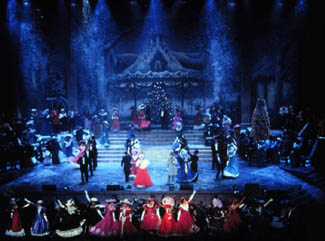 [pictured above, Act I--Turn of the Century "White
Christmas"] [pictured above, Act I--Turn of the Century "White
Christmas"]
To most people, the words "church Christmas pageant"
conjure up images of scenic drops that tremble, cardboard
angel wings, and dim light emanating from old coffee cans.
Then there's the Fort Lauderdale Christmas Pageant,
produced by the First Baptist Church of Fort Lauderdale. It's
a Radio City Music Hall-size spectacle that combines piety and
pizzazz in equal measure.
First, some fast facts: The pageant runs for 19
performances, and features a 300-voice chancel choir, a
40-piece orchestra, a combined cast and crew of over 1,000
people and a barnyard's worth of animals. The first half of
the show features traditional carols in a turn-of-the-century
setting, plus a children's parade, a winter wonderland
sequence, a downtown shopping scene, a choir concert, and an
international dance number. The second act traces the life of
Jesus Christ, from prophecies of His birth, through His death
and ascension into Heaven.
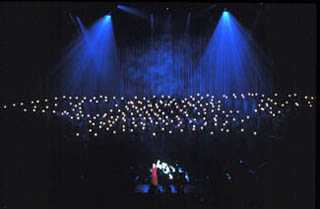 [pictured above, Act I--Beginning of Choir Concert
"Light A Christmas Candle." Reflects Jacques, "Over 250 lit
candles on stage! The fire marshal was in the Christmas
Spirit!"] [pictured above, Act I--Beginning of Choir Concert
"Light A Christmas Candle." Reflects Jacques, "Over 250 lit
candles on stage! The fire marshal was in the Christmas
Spirit!"]
Indeed, the pageant has grown so much since its beginning
in 1984 that it is now broadcast nationally on PBS; this year
it was shown in other countries as well.
The production represents a unique partnership between
professional and amateur theatre folk. The performers and
musicians are drawn from the local community. The design and
technical staff are professionals. (The scenery for the
production was designed by Peter Wolf and Bill Eckart, names
that will be familiar to an older generation of theatregoers).
For the last five years, the lighting has been designed by
David Jacques. The job never gets dull, however, according to
Jacques. For one thing, the first act format changes from year
to year. For another, the designer uses the latest lighting
equipment each year, resulting in new challenges and new
effects.
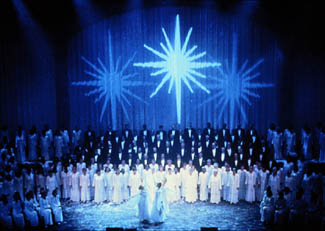 [pictured above, Act I--Choir Concert--Points out
Jacques, "The three stars (from Cybers) would track to the
center at the climax of the song...creating a sparkling giant
Christmas Star."] [pictured above, Act I--Choir Concert--Points out
Jacques, "The three stars (from Cybers) would track to the
center at the climax of the song...creating a sparkling giant
Christmas Star."]
A key fact about the pageant, says Jacques, is "each act is
a separate show. There is a wide range of musical and
emotional dynamics. The first act is pure entertainment, with
some secular tunes--it presents the message of the season. The
second act is the story of Jesus. Act I is mostly flash,
entertainment lighting, with a great deal of movement and
special effects. Act II is designed more like an opera. We
used the automated lighting in a more conventional way,
although there are some powerful effects."
The show is presented in the church's vast 3,000-seat
sanctuary, which presents both challenges and opportunities.
Both Jacques and automated lighting programmer Michael Irwin
agree that the lighting positions are far from the best.
"Because there's a height of 55'," says Irwin, "many lights
can only be reached for service by rappelling down to them. I
had a great master electrician, Michael Barman. This guy is a
champ. Any time we blew a lamp, he had to rappel down to the
front-of-house rig."
Furthermore, says Irwin, "In this particular venue, because
of the way the instruments are hung, it's a kind of
trapezoidal truss layout, over the pulpit and pews. You've got
a lot of side positions, but, as you back on the ceiling,
which also slopes up, the units are never in the same
orientation. It was a lot of fun programming all the
information." He adds that he worked out many of his
calculations using WYSIWIG.
Jacques says that he used the sanctuary's white, angular
sloping ceiling to create certain effects: "I also brought in
floor fixtures, [High End Systems] Technobeams with wide-angle
lenses" to do deck and ceiling treatments. "That was a
gamble," he adds. "I thought with the wide-angle lenses they
might be too weak, but they really kicked. I was really
surprised by their power. I was able to project lots of images
on the ceiling with them--stars, patterns, all sorts of
stuff."
This year, for the first time, Jacques used Coemar
equipment in his redesigned plot. "There are two plots for the
show," he says, "the truss plot and the front-of-house plot.
There are [High End Systems] Cyberlights and [Coemar] CF 1200s
at the front of house, placed on flying trusses and little
goalposts. There are also Cybers on the truss. In the past,
we've used Vari-Lite and Martin. There are also Cybers in the
FOH Torm positions. Due to budget restraints, this year I used
30% fewer automated lights. In the past, we’ve used Vari-Lite
and Martin. The nice thing about the Coemar units is that they
have a wonderful zoom and you can flood them out--so effects
that, in the past, required two lights, I could do with one
light this year. There are also 12 CF 1200s for area lighting,
color washes, and for scenes in the audience. are also 12 CF
1200s for area lighting, color washes, and for scenes in the
audience. These fixtures also aided in balancing for video."
Also, there are 24 Coemar CF 7 units hung on an overhead
truss. "In Act I, they're used for overhead gobos and
spotlights, and to light the drops. I needed a zoom
instrument, to go from pinpoints to something that would flood
out. I also used ministrips to light the drops. There are some
conventional units, but it's mostly an automated light show."
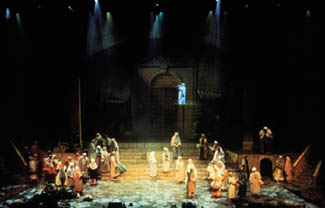 [pictured above, Act II--Jacques describes this scene
as, "Shofar revealed behind a scrim. The automated lighting
was used for specials and bold strokes of light."] [pictured above, Act II--Jacques describes this scene
as, "Shofar revealed behind a scrim. The automated lighting
was used for specials and bold strokes of light."]
Again, the designer notes, each act has a unique look. For
the first act, "There's a lot of color and movement and
morphing patterns. It's like most musicals. You have to design
it number by number and tie it into the overall theme of the
show. There are, I think, about 650 cues in the first act. In
the second act, there are 150 cues, in 80 minutes. You do tend
to get cue-intensive with automated lights."
Although the second act has a darker, more restrained look
in some respects, the designer also achieves a number
theatrical moments. For a Nativity sequence, the actor playing
Joseph holds up the infant (played by a real baby), and
there's a broad downward sweep of beams from CF7s onto the
infant. During the Last Supper sequence, says the designer,
"There are candlelight effects, from automated units, bouncing
off the table. You don't really 'see' it, but you know the
candlelight is there." The Crucifixion sequence begins with
the actor playing Christ dragging the cross across the stage.
In years past, the LD, says, "this is where the Martin PAL
units came in handy. I created a 'path of pain,' forming a
sharply shuttered road of stark white light through which he
walked. The chorus people stood behind, reaching their hands
into this wall of downlight. This year, not using the PALS, I
didn't have the same shuttering capability, so I used the
Technobeams from a low angle to create this wonderful shadow
effect as Jesus was carrying the cross."
Jacques uses Coemar units for the Crucifixion itself, three
CF 1200s for toplighting on the cross and backlighting the
archway downstage of it. The Resurrection, he says, "is simple
but effective. The tomb is downstage of the crosses; the front
is made of scrim, so we bleed light through it. There's a huge
beam of light from a CF 1200 above and slightly upstage--it's
a kind of 'God light' that pierces Jesus. The next moment,
light cuts through the roof of the tomb. Additional ‘God
lights’ bump on DS of the tomb supporting the climax of the
music. Jesus stands, turns upstage, and exits the tomb, and
there’s a crossfade, from the CF 1200s to a blinding light
located directly upstage from an unseen stagehand holding a
par can. We go from super high-tech to super low-tech in a
matter of seconds."
 [pictured above, Act II--The Path of Pain--Jacques says
to notice "the choir reaching in to the wall of stark
light."] [pictured above, Act II--The Path of Pain--Jacques says
to notice "the choir reaching in to the wall of stark
light."]
Jacques emphasizes the key role played by Irwin on the
production. I've used the two best programmers in the world on
this show--Jorge Valdez, when we had Martin equipment, and now
Mike Irwin. I have used people in the past who weren't of
their caliber, and it's a waste of money. The
designer-programmer interface is so crucial; if you don't have
a programmer who can clue into your style…well, let's just say
that you have to be a very open person to be a programmer."
Other key personnel included associate lighting designer
Helena Kuukka ("One of the finest assistants in the country,
and a wonderful designer who contributes greatly to this
production," says Jacques), assistant lighting designer
Michael Schrupp (one of Jacques’ graduate students), and
production manager Ryan Bates, whose company Majestic
Productions, provided most of the professional backstage labor
force.
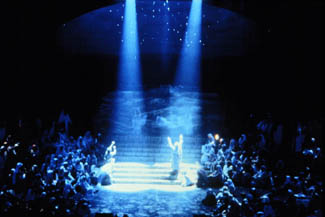 [pictured above, Act II--The Resurrection--Jacques used
"God Lights" from CF1200s to "illuminate the saved DS of the
tomb."] [pictured above, Act II--The Resurrection--Jacques used
"God Lights" from CF1200s to "illuminate the saved DS of the
tomb."]
The automated lighting is run on a High End Systems
Wholehog console, with the conventional units controlled by an
ETC Express.
Overall, says, Jacques, the experience continues to be a
positive one. "This was the first show I've ever done for a
church organization," he says. "I enjoy working with these
people. They really respect your creativity." That's Christmas
present enough for any designer.
The complete lighting equipment list, as supplied by Miami
Stagecraft, follows: 6 High End Systems Technobeams w/
wide angle lens
21 Coemar CF7 Hard Edge
10 High End
Systems Cyberlight (4 with narrow lens set)
15 Coemar
CF1200 Wash
1 Whole Hog II Console with Remote
1 Hog
1000 Console (backup)
18 ETC S4 10°
53 ETC S4
19°
70 ETC S4 26°
9 ETC S4 50°
14 Lighting and
Electronics Mini strip 3 circuit 6'
3 Wildfire 400
spot/flood UV fixtures
4 Lighting and Electronics 4.5"
fresnel
2 GAM Flicker generators
1 22" mirror ball
& motor
2 Lycian 1275 Long Throw followspots
2
Altman Voyager Short Throw Truss follow spots
3 Grey
Interfaces Opto splitter
1 Le Maitre LSG low smoke
generator
House equipment at the church includes the ETC Express
console, ETC dimmers, four Strand Par 64s, 60 Strand
Lekolights, and two Lycian 1266 followspots.
Photos: David Jacques. |





